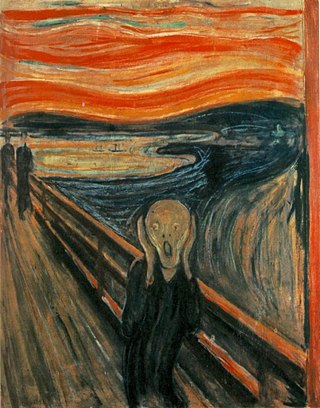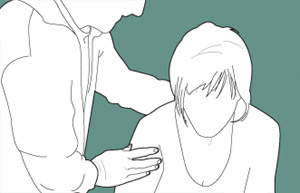
Anxiety is an emotion which is characterised by an unpleasant state of inner turmoil and includes feelings of dread over anticipated events. Anxiety is different from fear in that fear is defined as the emotional response to a real threat, whereas anxiety is the anticipation of a future threat. It is often accompanied by nervous behavior such as pacing back and forth, somatic complaints, and rumination.

A phobia is an anxiety disorder, defined by an irrational, unrealistic, persistent and excessive fear of an object or situation. Phobias typically result in a rapid onset of fear and are usually present for more than six months. Those affected go to great lengths to avoid the situation or object, to a degree greater than the actual danger posed. If the object or situation cannot be avoided, they experience significant distress. Other symptoms can include fainting, which may occur in blood or injury phobia, and panic attacks, often found in agoraphobia and emetophobia. Around 75% of those with phobias have multiple phobias.

Anxiety disorders are a cluster of mental disorders characterized by significant and uncontrollable feelings of anxiety and fear such that a person's social, occupational, and personal functions are significantly impaired. Anxiety may cause physical and cognitive symptoms, such as restlessness, irritability, easy fatigue, difficulty concentrating, increased heart rate, chest pain, abdominal pain, and a variety of other symptoms that may vary based on the individual.

Agoraphobia is a mental and behavioral disorder, specifically an anxiety disorder characterized by symptoms of anxiety in situations where the person perceives their environment to be unsafe with no easy way to escape. These situations can include public transit, shopping centers, crowds and queues, or simply being outside their home on their own. Being in these situations may result in a panic attack. Those affected will go to great lengths to avoid these situations. In severe cases, people may become completely unable to leave their homes.

Panic attacks are sudden periods of intense fear and discomfort that may include palpitations, sweating, chest pain or chest discomfort, shortness of breath, trembling, dizziness, numbness, confusion, or a feeling of impending doom or of losing control. Typically, symptoms reach a peak within ten minutes of onset, and last for roughly 30 minutes, but the duration can vary from seconds to hours. Although they can be extremely frightening and distressing, panic attacks themselves are not physically dangerous.
Specific phobia is an anxiety disorder, characterized by an extreme, unreasonable, and irrational fear associated with a specific object, situation, or concept which poses little or no actual danger. Specific phobia can lead to avoidance of the object or situation, persistence of the fear, and significant distress or problems functioning associated with the fear. A phobia can be the fear of anything.
Self-medication, sometime called do-it-yourself (DIY) medicine, is a human behavior in which an individual uses a substance or any exogenous influence to self-administer treatment for physical or psychological conditions, for example headaches or fatigue.
Generalized anxiety disorder (GAD) is a mental and behavioral disorder, specifically an anxiety disorder characterized by excessive, uncontrollable and often irrational worry about events or activities. Worry often interferes with daily functioning, and individuals with GAD are often overly concerned about everyday matters such as health, finances, death, family, relationship concerns, or work difficulties. Symptoms may include excessive worry, restlessness, trouble sleeping, exhaustion, irritability, sweating, and trembling.
Mental health professionals often distinguish between generalized social phobia and specific social phobia. People with generalized social phobia have great distress in a wide range of social situations. Those with specific social phobia may experience anxiety only in a few situations. The term "specific social phobia" may also refer to specific forms of non-clinical social anxiety.
Psychological dependence is a cognitive disorder that involves emotional–motivational withdrawal symptoms – such as anxiety or anhedonia – upon cessation of prolonged drug abuse or certain repetitive behaviors. It develops through frequent exposure to certain psychoactive substances or behaviors, which leads to an individual requiring further exposure to avoid withdrawal symptoms, as a result of negative reinforcement. Neuronal counter-adaptation is believed to play a role in generating withdrawal symptoms, which could be mediated through changes in neurotransmitter activity or altered receptor expression. Environmental enrichment and physical activity can attenuate withdrawal symptoms.
Social anxiety is the anxiety and fear specifically linked to being in social settings. Some categories of disorders associated with social anxiety include anxiety disorders, mood disorders, autism spectrum disorders, eating disorders, and substance use disorders. Individuals with higher levels of social anxiety often avert their gazes, show fewer facial expressions, and show difficulty with initiating and maintaining a conversation. Social anxiety commonly manifests itself in the teenage years and can be persistent throughout life; however, people who experience problems in their daily functioning for an extended period of time can develop social anxiety disorder. Trait social anxiety, the stable tendency to experience this anxiety, can be distinguished from state anxiety, the momentary response to a particular social stimulus. Half of the individuals with any social fears meet the criteria for social anxiety disorder. Age, culture, and gender impact the severity of this disorder. The function of social anxiety is to increase arousal and attention to social interactions, inhibit unwanted social behavior, and motivate preparation for future social situations.

Social anxiety disorder (SAD), also known as social phobia, is an anxiety disorder characterized by sentiments of fear and anxiety in social situations, causing considerable distress and impairing ability to function in at least some aspects of daily life. These fears can be triggered by perceived or actual scrutiny from others. Individuals with social anxiety disorder fear negative evaluations from other people.

Panic disorder is a mental and behavioral disorder, specifically an anxiety disorder characterized by reoccurring unexpected panic attacks. Panic attacks are sudden periods of intense fear that may include palpitations, sweating, shaking, shortness of breath, numbness, or a feeling that something terrible is going to happen. The maximum degree of symptoms occurs within minutes. There may be ongoing worries about having further attacks and avoidance of places where attacks have occurred in the past.
Experts from many different fields have conducted research and held debates about how using social media affects mental health. Research suggests that mental health issues arising from social media use affect women more than men and vary according to the particular social media platform used, although it does affect every age and gender demographic in different ways. Psychological or behavioural dependence on social media platforms can result in significant negative functions in individuals' daily lives. Studies show there are several negative effects that social media can have on individuals' mental health and overall well-being. While researchers have attempted to examine why and how social media is problematic, they still struggle to develop evidence-based recommendations on how they would go about offering potential solutions to this issue. Because social media is constantly evolving, researchers also struggle with whether the disorder of problematic social media use would be considered a separate clinical entity or a manifestation of underlying psychiatric disorders. These disorders can be diagnosed when an individual engages in online content/conversations rather than pursuing other interests.
Separation anxiety disorder (SAD) is an anxiety disorder in which an individual experiences excessive anxiety regarding separation from home and/or from people to whom the individual has a strong emotional attachment. Separation anxiety is a natural part of the developmental process. It is most common in infants and little children, typically between the ages of six to seven months to three years, although it may pathologically manifest itself in older children, adolescents and adults. Unlike SAD, normal separation anxiety indicates healthy advancements in a child's cognitive maturation and should not be considered a developing behavioral problem.

Problematic smartphone use is psychological or behavioral dependence on cell phones. It is closely related to other forms of digital media overuse such as social media addiction or internet addiction disorder.
Safety behaviors are coping behaviors used to reduce anxiety and fear when the user feels threatened. An example of a safety behavior in social anxiety is to think of excuses to escape a potentially uncomfortable situation. These safety behaviors, although useful for reducing anxiety in the short term, might become maladaptive over the long term by prolonging anxiety and fear of nonthreatening situations. This problem is commonly experienced in anxiety disorders. Treatments such as exposure and response prevention focus on eliminating safety behaviors due to the detrimental role safety behaviors have in mental disorders. There is a disputed claim that safety behaviors can be beneficial to use during the early stages of treatment.
The Screen for Child Anxiety Related Emotional Disorders (SCARED) is a self-report screening questionnaire for anxiety disorders developed in 1997. The SCARED is intended for youth, 9–18 years old, and their parents to complete in about 10 minutes. It can discriminate between depression and anxiety, as well as among distinct anxiety disorders. The SCARED is useful for generalized anxiety disorder, social anxiety disorder, phobic disorders, and school anxiety problems. Most available self-report instruments that measure anxiety in children look at general aspects of anxiety rather than Diagnostic and Statistical Manual of Mental Disorders (DSM) categorizations. The SCARED was developed as an instrument for both children and their parents that would encompass several DSM-IV and DSM-5 categorizations of the anxiety disorders: somatic/panic, generalized anxiety, separation anxiety, social phobia, and school phobia.
The relationships between digital media use and mental health have been investigated by various researchers—predominantly psychologists, sociologists, anthropologists, and medical experts—especially since the mid-1990s, after the growth of the World Wide Web. A significant body of research has explored "overuse" phenomena, commonly known as "digital addictions", or "digital dependencies." These phenomena manifest differently in many societies and cultures. Some experts have investigated the benefits of moderate digital media use in various domains, including in mental health, and the treatment of mental health problems with novel technological solutions.









